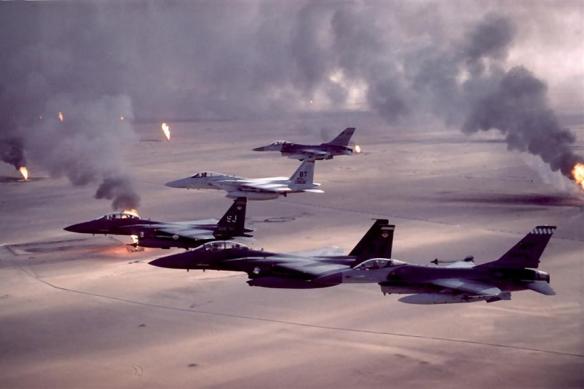Operation Desert Saber
The land offensive Operation Desert Saber was launched on February 23, 1991, and lasted for four days. Deployment of ground troops was restrained until nearly the entire Iraqi infrastructure, including bridges, highways, electric power systems, water filtration plants, and airports, had been destroyed. With thousands of Iraqis already dead, surviving troops surrendered by the tens of thousands. The few Iraqi troops, including many of the elite Republican Guard, who continued to fight while retreating, shot their surrendering comrades in the back. When President Bush ordered a cease-fire on February 27, Kuwait was liberated, and the most extensive air bombardment and land offensive since World War II was over. Bush’s early termination of the ground war was later criticized, as Baghdad was able to rescue a substantial amount of military equipment, which was later used to suppress postwar Shiite and Kurdish rebellions as Hussein remained in power.
Military Warcraft
Initial air attacks led by the United States included Tomahawk cruise missiles launched from warships in the Persian Gulf, F-117A stealth fighter-bombers armed with smart bombs, and F-4G Wild Weasel aircraft loaded with antiradar missiles. These attacks permitted F-14, F-15, and F-16 fighter-bombers, and F/A-18 Hornet fighters to gain air superiority. Bombing missions were timed to reduce the effectiveness of Iraqi ground radar defenses. The A-10 Thunderbolt, with its Gatling gun and heat-seeking or optically-guided Maverick missiles, effectively provided support for ground units. Other essential coalition support was provided by the AH-64 Apache, Black Hawk, AH-1 Cobra, and Super Cobra helicopters, which fired laser-guided Hellfire missiles, the E-3A airborne warning and control system (AWACS), and a modernized fleet of older B-52G’s. The coalition’s 2,250 combat aircraft, including 1,800 U.S. planes, were no match for Iraq’s 500 Soviet built MiG-29’s and French-made Mirage F-1’s. Coalition combat missions dropped more than 88,000 tons of bombs. Precision-guided missiles, night-vision devices, an infrared navigation and target designation system, and target sensors enabled round-the-clock bombing by the coalition. Ground-based firepower included the multiple-launch rocket system, the M-2 Infantry Fighting Vehicle, the M-60A3 main battle tank, the M-109 self-propelled howitzer tank, the M-1A1 main battle tank, and ninety Patriot missile launchers.
Casualties and Aftermath
Immediately following the Gulf War, the United States Defense Intelligence Agency estimated that 100,000 Iraqi soldiers had been killed, 300,000 wounded, 150,000 deserted, and 60,000 taken prisoner. U.S. representatives later stated these estimates could be off as much as 50 percent following claims by various human rights organizations of significantly different numbers. U.S. casualties included 148 killed in action, 407 wounded, and 121 killed in nonhostile activities, such as friendly fire.
Coalition bombing severely damaged Iraq’s transportation systems, communication systems, and petroleum and other industries. Much of Iraq’s electric power and clean water were destroyed, resulting in many civilian deaths from lack of food or medical treatment. Severe environmental pollution resulted after Hussein ordered approximately six hundred Kuwaiti oil wells set afire. The blazes took more than twelve months to extinguish and caused severe air pollution. Huge amounts of Kuwaiti oil were dumped into the Persian Gulf as the war ended. Postwar economic sanctions continued to cause great hardship to the civilians of Iraq and neighboring countries, as efforts to strip Hussein of power repeatedly failed. The operation had another, unintended effect: The presence of U.S. troops angered Osama bin Laden and other Islamic fundamentalists. The terrorist attacks of September 11, 2001, that killed more than five thousand were tied to the Gulf War.
Following Gulf War duty, many veterans complained of physical and psychological ailments, including memory loss, fatigue, and joint pain, collectively known as Gulf War syndrome. In 1996, the Pentagon warned five thousand veterans of the war that these symptoms might have been caused by exposure to nerve gas during an attack on a weapons depot.
Bibliography Christy, Joe. American Aviation: An Illustrated History. Blue Ridge Summit, Pa.: Tab Books, 1987. An excellent review text on U.S. aviation history, with interesting insights into the past and potential future of airwarfare. Cooksley, Peter G., and Bruce Robertson. Air Warfare: The Encyclopedia of Twentieth Century Conflict. London, England: Arms and Armour Press, 1998. A chronology of significant events, inventions, and aeronautic milestones in armed flight. Donald, David, ed. The Complete Encyclopedia of World Aircraft. New York: Barnes & Noble Books, 1997. A superb text with essays that examine the critical role of air power in international security by looking systematically at strategy and targeting. Includes photos, drawings, and statistics on essentially every airplane ever constructed. Keaney, Thomas A., and Eliot A. Cohen. Revolution in Warfare? Air Power in the Persian Gulf. Annapolis, Md.: Naval Institute Press, 1995. A comprehensive account of the 1991 Gulf War, containing a revised edition of the Persian Gulf War Air Power Survey Summary Report created by Secretary of the Air Force, Donald B. Rice. Price, Alfred. Sky Battles: Dramatic Air Warfare Battles. Dulles, Va.: Continuum, 1999. This fascinating text for the lay reader sensationally and accurately lives up to its title.
